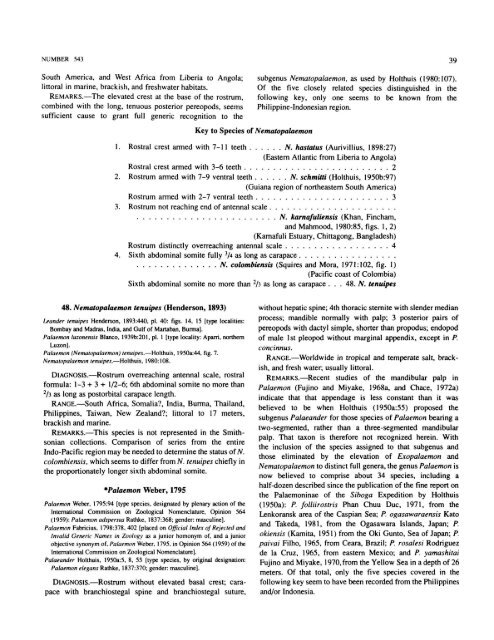Part 2 - AToL Decapoda
Part 2 - AToL Decapoda
Part 2 - AToL Decapoda
Create successful ePaper yourself
Turn your PDF publications into a flip-book with our unique Google optimized e-Paper software.
NUMBER 543 39<br />
South America, and West Africa from Liberia to Angola;<br />
littoral in marine, brackish, and freshwater habitats.<br />
REMARKS.—The elevated crest at the base of the rostrum,<br />
combined with the long, tenuous posterior pereopods, seems<br />
sufficient cause to grant full generic recognition to the<br />
Key to Species of Nematopalaemon<br />
subgenus Nematopalaemon, as used by Holthuis (1980:107).<br />
Of the five closely related species distinguished in the<br />
following key, only one seems to be known from the<br />
Philippine-Indonesian region.<br />
1. Rostral crest armed with 7-11 teeth N. hastatus (Aurivillius, 1898:27)<br />
(Eastern Atlantic from Liberia to Angola)<br />
Rostral crest armed with 3-6 teeth 2<br />
2. Rostrum armed with 7-9 ventral teeth N. schmitti (Holthuis, 1950b:97)<br />
(Guiana region of northeastern South America)<br />
Rostrum armed with 2-7 ventral teeth 3<br />
3. Rostrum not reaching end of antennal scale<br />
N. karnafuliensis (Khan, Fincham,<br />
and Mahmood, 1980:85, figs. 1, 2)<br />
(Karnafuli Estuary, Chittagong, Bangladesh)<br />
Rostrum distinctly overreaching antennal scale 4<br />
4. Sixth abdominal somite fully 3 /4 as long as carapace<br />
N. colombiensis (Squires and Mora, 1971:102, fig. 1)<br />
(Pacific coast of Colombia)<br />
Sixth abdominal somite no more than 2 /3 as long as carapace ... 48. N. tenuipes<br />
48. Nematopalaemon tenuipes (Henderson, 1893)<br />
Leander tenuipes Henderson, 1893:440, pi. 40: figs. 14, 15 [type localities:<br />
Bombay and Madras, India, and Gulf of Martaban, Burma].<br />
Palaemon luzonensis Blanco, 1939b:201, pi. 1 [type locality: Aparri. northern<br />
Luzon].<br />
Palaemon (Nematopalaemon) tenuipes.—Holthuis, 1950a:44, fig. 7.<br />
Nematopalaemon tenuipes.—Holthuis, 1980:108.<br />
DIAGNOSIS.—Rostrum overreaching antennal scale, rostral<br />
formula: 1-3 + 3 + 1/2-6; 6th abdominal somite no more than<br />
2 /3 as long as postorbital carapace length.<br />
RANGE.—South Africa, Somalia?, India, Burma, Thailand,<br />
Philippines, Taiwan, New Zealand?; littoral to 17 meters,<br />
brackish and marine.<br />
REMARKS.—This species is not represented in the Smithsonian<br />
collections. Comparison of series from the entire<br />
Indo-Pacific region may be needed to determine the status of N.<br />
colombiensis, which seems to differ from N. tenuipes chiefly in<br />
the proportionately longer sixth abdominal somite.<br />
*Palaemon Weber, 1795<br />
Palaemon Weber, 1795:94 [type species, designated by plenary action of the<br />
International Commission on Zoological Nomenclature, Opinion 564<br />
(1959): Palaemon adspersus Rathke, 1837:368; gender: masculine].<br />
Palaemon Fabricius. 1798:378. 402 [placed on Official Index of Rejected and<br />
Invalid Generic Names in Zoology as a junior homonym of, and a junior<br />
objective synonym of, Palaemon Weber, 1795, in Opinion 564 (1959) of the<br />
International Commission on Zoological Nomenclature].<br />
Palaeander Holthuis, 1950a:5, 8, 55 [type species, by original designation:<br />
Palaemon elegans Rathke, 1837:370; gender: masculine].<br />
DIAGNOSIS.—Rostrum without elevated basal crest; carapace<br />
with branchiostegal spine and branchiostegal suture,<br />
without hepatic spine; 4th thoracic sternite with slender median<br />
process; mandible normally with palp; 3 posterior pairs of<br />
pereopods with dactyl simple, shorter than propodus; endopod<br />
of male 1st pleopod without marginal appendix, except in P.<br />
concinnus.<br />
RANGE.—Worldwide in tropical and temperate salt, brackish,<br />
and fresh water; usually littoral.<br />
REMARKS.—Recent studies of the mandibular palp in<br />
Palaemon (Fujino and Miyake, 1968a, and Chace, 1972a)<br />
indicate that that appendage is less constant than it was<br />
believed to be when Holthuis (1950a:55) proposed the<br />
subgenus Palaeander for those species of Palaemon bearing a<br />
two-segmented, rather than a three-segmented mandibular<br />
palp. That taxon is therefore not recognized herein. With<br />
the inclusion of the species assigned to that subgenus and<br />
those eliminated by the elevation of Exopalaemon and<br />
Nematopalaemon to distinct full genera, the genus Palaemon is<br />
now believed to comprise about 34 species, including a<br />
half-dozen described since the publication of the fine report on<br />
the Palaemoninae of the Siboga Expedition by Holthuis<br />
(1950a): P. folliirostris Phan Chuu Due, 1971, from the<br />
Lenkoransk area of the Caspian Sea; P. ogasawaraensis Kato<br />
and Takeda, 1981, from the Ogasawara Islands, Japan; P.<br />
okiensis (Kamita, 1951) from the Oki Gunto, Sea of Japan; P.<br />
paivai Filho, 1965, from Ceara, Brazil; P. rosalesi Rodriguez<br />
de la Cruz, 1965, from eastern Mexico; and P. yamashitai<br />
Fujino and Miyake, 1970, from the Yellow Sea in a depth of 26<br />
meters. Of that total, only the five species covered in the<br />
following key seem to have been recorded from the Philippines<br />
and/or Indonesia.

















